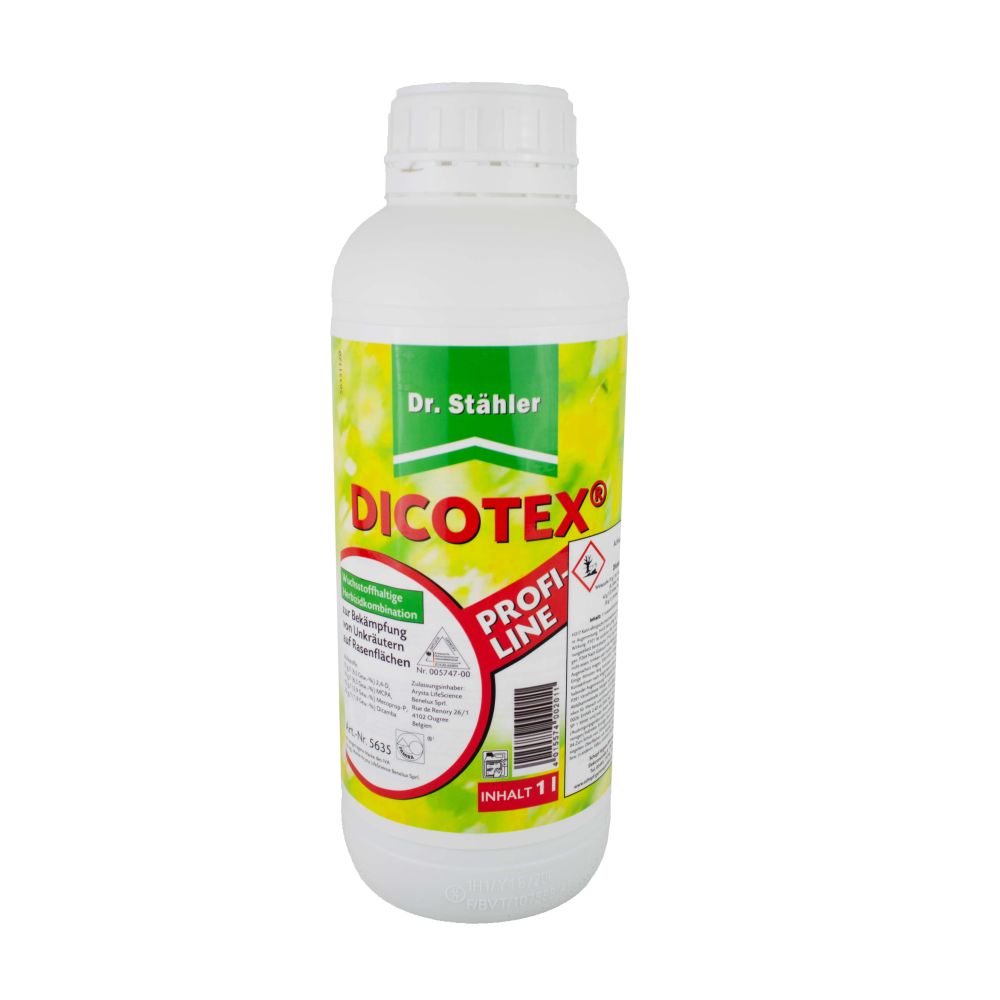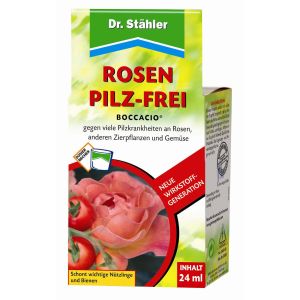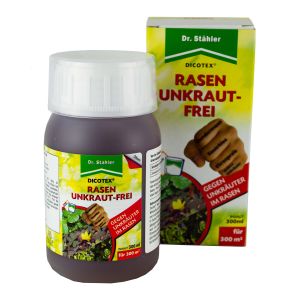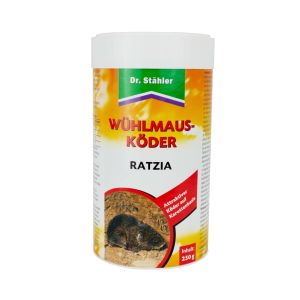Dr. Stähler Dicotex® Lawn Weed-Free 1 Liter - Water soluble ready-to-use herbicide
Dicotex is a herbicidal, water-soluble concentrate for professional use from Dr. Stähler
Dr. Stähler Dicotex Weed-Free is a herbicide containing growing media for the control of weeds in lawns and contains four active ingredients that are absorbed both through the leaf and, to a lesser extent, through the roots of the weeds and are then systemically distributed throughout the plant.
The 4-fold mixture in Dr. Stähler Dicotex Weed-Free ensures a very broad spectrum of action, so that in addition to common easily controlled weeds such as dandelion, daisy and white clover, problem weeds such as groundsel and speedwell are also reliably controlled. At the same timeDr. Stähler Dicotex Weed-Free has a very good lawn compatibility. Dr. Stähler Dicotex Weed-Free is not dangerous to bees and can therefore be used without restriction - even on flowering weeds.
Active ingredients: 70 g/l (6.5 wt.%) 2,4-D, 70 g/l (6.5 wt.%) MCPA, 42 g/l (3.9 wt.%) Mecoprop-P, 20 g/l (1.9 wt.%) Dicamba
Hazard symbols: GHS07 - Plant protection expertise required, see note below in the text.
Registration number: 005747-63
Authorisation expiry date: 31.10.2022
(Permitted in home and allotment gardens)
Anleitung / Instruction / Instruktioner for Dicotex®
Safety Data Sheet
Fields of application and conditions of use specified by the regulatory authority
Dicotyledonous Weeds Turf
Do not allow application fluids and their residues, product and its residues, emptied containers or packages as well as cleaning and rinsing fluids to reach water bodies. This also applies to indirect discharges via sewers, yard and street drains, and storm and sanitary sewers (NW468).
For spray application the following additionally applies:
The application of the agent must be carried out in a width of at least 20 m to adjacent areas (excluding areas used for agriculture or horticulture, roads, paths and squares) with a loss-reducing device which is listed in the "Loss-reducing devices" list of 14. October 1993 (Federal Gazette No. 205, p. 9780), as amended, at least in the drift reduction class 90 %. When applying the agent, the use of loss reducing technology is not necessary if the application is carried out with portable plant protection devices or if adjacent areas (e. g. (e.g. field margins, hedges, grove islands) are less than 3 m wide or the product is applied in an area which has been designated as an agricultural landscape with a sufficient proportion of small structures by the Federal Biological Research Centre in the "List of regionalised small structure proportions" of 7 February 2002 (Federal Gazette No. 70a of 13 April 2002), as amended (NT103).
Application ornamental horticulture lawn (open field)
Against dicotyledonous weeds: 100 ml/100 m² water in 100 l/100 m² water as eyrie or single plant treatment,
Time of application: during the vegetation period, April to September. Do not use in the year of sowing. Max. 1 application in the crop or per year.water in 1000 l/1000 m² water, application time: spring to autumn. Do not use in the year of sowing. Max. 1 application in the crop or per year. Do not feed harvested crop/mown crop produced in the year of treatment (VV207).
Spectrum of activity
Good control:
wild mustard, rushes, common plantain, brunella/brown aphid, sweet clover, cinquefoil, speedwell, daisy, garden foamwort, common ragwort, common foxtail, common hornwort*, greater sorrel, groundsel, shepherd's purse, shepherd's purse, ragweed, ragweed, shepherd's purse, shepherd's purse, shepherd's purse, shepherd's purse, shepherd's purse, shepherd's purse, shepherd's purse, shepherd's purse, shepherd's purseragwort, common ragwort, common sorrel, goosegrass, shepherd's purse, ragwort, creeping buttercup, lesser sorrel, dandelion, meadow buttercup, common ragwort, creeping balsamplantain, ribwort, ragwort, wood sorrel*, yarrow, bird's-foot trefoil, chickweed, white clover, vetches, wild carrot, bindweed
Less well controlled:
goutweed, horsetail, hogweed, meadow chervil
Not (sufficiently) controllable:
Grasses, mosses
Mechanism of action (WMO) according to HRAC: O
*Note: Effect against horned clover and wood sorrel not always certain. In case of difficult control, it is recommended to concentrate to 2 ml per l water in the watering broth and to drain the weed nests individually. Make sure that the total permissible application rate of 1 ml/m² is not exceeded.
Plant compatibility ornamental and sports turf:
Incompatibilities cannot be excluded on individual grass varieties in the year of sowing due to the given variety. Therefore, Dicotex may only be used from the first year of establishment.
Application technique
Preparation of the spraying mixture
Add Dicotex in the required quantity (100 ml/100 m²) to half of the watering or spraying mixture. The water requirement for the watering method is 100 l/100 m², for the spraying method 10 l/100 m². Fill up with the remaining amount of water, stir well the watering/spraying mixture. Recommended water application rate Lawn/watering method 100 l/100 m² Lawn/spraying method 10 l/100 m²
Application technique
Water with watering rake or sprayer or sprayer on well developed weeds or at rosette stage.
Important Notes: Dicotex should be applied during the growing season when the weather is vigorous (from 15 °C to 25 °C) and the foliage is well developed, ensuring even distribution for safe efficacy. Do not apply shortly after mowing (wait at least 5 days). When using Dicotex, the leaves should be dry and it should remain dry for several hours (6 hours) after application. Weeds such as white clover show visible changes after a few days. With other weeds such as speedwell and plantain species, it may take several weeks before the final control result is achieved. Nevertheless, the next lawn cutting can take place approx. 5 days after the application of Dicotex.
Apply to turf only:
Do not apply in close proximity to broadleaf ornamental or cultivated plants or non-ornamental plants that should not be controlled and should not come into contact with the product.
Cleaning
Thoroughly clean watering equipment after use on unsealed soil first with water, then with detergent solution. Apply cleaning water to previously treated area. Thoroughly clean spraying equipment and lines with water after use. To do this, fill approx. 20 % of the tank contents with water, spraying the inner surfaces of the tank with the water jet. Switch on agitator for approx. 2 minutes. Then spray cleaning liquid through the nozzles on the previously treated area while the agitator is running. The regular cleaning of the crop protection sprayer from the outside, especially of the spray agent tank, pump unit and boom, should be part of the normal operational procedure and if possible be carried out directly in the field. For this purpose the implement manufacturers offer appropriate retrofit kits with water reservoirs and cleaning brushes. As a matter of principle clean the sprayer immediately after the spraying operation in order to avoid drying. When cleaning the inside of the sprayer, also pay attention to all fittings and hoses and, when spraying empty afterwards, also empty the sprayer boom completely in the field. Waiting time turf: The waiting time is covered by the application conditions and/or the growing season that remains between application and use (e.g. harvest) or it is not necessary to specify a waiting time in days.
Environmental fate
Bees
The product is classified as non-hazardous to bees (B4) up to the highest application rate or application concentration specified in the authorisation, if an application rate is not specified (NB6641).
Beneficial insects
The product is classified as non-harmful to populations of the species Pardosa amentata and palustris (wolf spiders) (NN130). The agent is classified as non-harmful to populations of the species Poecilus cupreus (ground beetle) (NN165).
Aquatic Plants
The agent is toxic to higher aquatic plants (NW265).
Algae
The agent is toxic to algae (NW262).
Waters/groundwater
The application of the product in or directly on surface waters or coastal waters is not permitted (§ 6 Para. 2 PflSchG). Irrespective of this, the mandatory minimum distance to surface waters as stipulated by federal state law must be observed. Violations can be punished with a fine of up to 50,000 euros (NW642).
Storage
Storeseparately from food and feed, out of reach of children and only in the sealed original packaging.
Information for safe handling
To avoid risks to humans and the environment, follow the directions for use (SP001).
User protection
Avoid all unnecessary contact with the product. Misuse may cause damage to health (SB001). The guideline for the requirements for personal protective equipment in plant protection "Personal protective equipment when handling plant protection products" of the Federal Office of Consumer Protection and Food Safety must be observed (SB110). Wear tightly fitting protective goggles when handling the undiluted agent (SE110). Re-entry into the treated areas/crops on the day of application is only possible with the personal protective equipment specified for the application of the agent. Subsequent work on/on treated areas/crops may only be carried out 24 hours after application of the agent. Within 48 hours the protective suit against crop protection agents and universal protective gloves (crop protection) must be worn (SF1891). During follow-up work in freshly treated plants, work clothes (at least long-sleeved shirt and long pants) and gloves must be worn (SF190). Do not use treated turf as a playground or lawn until after the next cut (SF243). Wear all-purpose protective gloves (crop protection) when handling undiluted product (SS110). Wear protective clothing against crop protection agents and sturdy footwear (e.g. rubber boots) when handling the undiluted agent (SS2101). Wear protective clothing against crop protection agents and sturdy footwear (e.g. rubber boots) when applying/handling the ready-to-use agent (SS2202). Wear rubber apron when handling the undiluted product (SS610). Labelling GefStoffV R 43: May cause sensitisation by skin contact. R 51/53: Toxic to aquatic organisms, may cause long-term adverse effects in the aquatic environment. S 2: Keep out of the reach of children. S 13: Keep away from food, drink and animal feeding stuffs. S 23: Do not breathe vapour/aerosol. S 24: Avoid contact with skin. S 35: Waste and containers must be disposed of in a safe way. S 36/37: Wear suitable protective clothing and gloves. S 46: If swallowed, seek medical advice immediately and show this container or label. S 51: Use only in well ventilated areas. S 57: Use suitable container to avoid environmental contamination. Contains 2,4-D. May cause allergic reactions. To avoid risks to man and the environment, follow the instructions for use. - SP001 Packaging must not be reused.
Safety data sheet available on request for professional users.
This product is not approved for home and small garden use from the 1 litre container upwards! It may only be purchased by persons with plant protection expertise.
ATTENTION IMPORTANT: For the purchase of this product we need a copy of your certificate of competence as well as a copy of your passport.
Please mail or fax us the necessary data.
These persons need the certificate of competence
- Persons who apply plant protection products
- who advise on plant protection
- instruct or supervise other non-expert persons
- as well as placing plant protection products on the market


| Delivery time | 2-3 Tage |
|---|---|
| EAN | 4015574002011 |
| Manufacturer Article no. | 5635 |
| Manufacturer | Dr. Stähler |
| Active ingredients | 2,4-D, Dicamba, MCPA, Mecoprop-P |
| Pestizid | Yes |
Manufacturer: Schopf Hygiene Bitterfeld GmbH & Co.KG, Elektronstrasse 8, 06749 Bitterfeld-Wolfen, DE, info@schopf-bitterfeld.de








